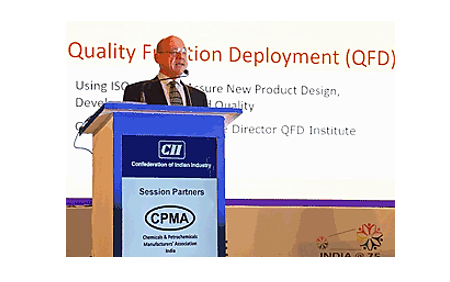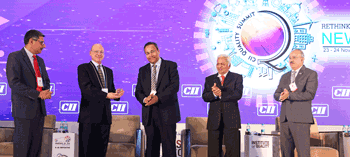The Economic Times reported back on June 2019 that India was forecast to overtake the UK, becoming the world's fifth largest economy this year and by 2025 surpassing Japan to feature at the second position in the Asia-Pacific region.
From what we have observed recently at the the Confederation for Indian Industry (CII) Quality Summit and QFD Green Belt® masterclass, the country is making tremendous inroads toward learning and applying the latest Quality methods and supporting their industry in this effort. This includes their full embrace for the cutting-edge ISO 16355 Blitz QFD® for new product development.
Those who still insist on the 1960s' House of Quality and specification-centric approaches (such as the 4-phase model) should take notice. Indian industry is ready to eclipse these outmoded product developers with their innovative minds. Let us share the current status.
The QFD Green Belt® masterclass was held in November 2019 at the CII headquarters in Bangalore, with over 55 delegates in attendance. The delegates represented mainly manufacturing organizations such as automotive, machine tools, agriculture, and various industrial products, but also in attendance were those in service and even jewelry and fashion businesses.
The masterclass used the Modern Blitz QFD® flow and the participants were able to apply the core Blitz QFD® tools to the projects from their own companies. It was evident that CII has done an excellent job in training its industry members on Total Productive Maintenance and Total Quality Management tools and methods. The masterclass delegates were able to grasp the value of moving their new product development mindset upstream without difficulties, moving from the manufacturing floor to the design studio, R&D center, and marketing activities needed to calify which customer needs were most critical to improve or redesign in their next generation product.
Furthermore, since many of the core Blitz QFD® tools were familiar to them, they could easily refocus from solving their own process problems to solving their customer's process or life problems. The tools that was perhaps most helpful was the re-orientation of the standard problem solving "fishbone" diagram (also known as the Ishikawa Diagram or cause-and-effect diagram) to the Blitz QFD® Wishbone Diagram for extracting "true" customer needs from the voice of customer (VOC) verbatims and observations.
For example, in the luxury and fashion industry, typical VOC statements might say that the customers want precious stones and metals when selecting a jewelry. The QFD masterclass taught these producers how to better model their customer benefits away from the stated VOC, and instead translate them into 'true' customer need statements, such as "impress my in-laws," "make me look more attractive on my special day," and "preserve my investment." This enables them to identify more innovative solutions that also delight customers, by using the ISO 16355 modern QFD tools.
As in all public QFD Green Belt® classes, individual coaching for each attendee was available during the workshop sessions. This coaching will prove invaluable as each delegate challenges their Full QFD Green Belt® Certification over the next twelve months.
The 27th CII Quality Summit was held, following the the QFD masterclass. Over 600 delegates attended from across Indian industries, governmental, and NGO organizations.
QFD Institute participation included a brief Keynote address discussing the conference theme of "Rethinking Quality for New India," stressing that the shift must now take place from the "zero defect" thinking to add "positive" customer experiences through the use of QFD. This was reinforced in an afternoon presentation “Quality Imperatives for Customer Delight" where details of the new ISO 16355 standard for QFD were introduced. On the final day of the Summit, two QFD webcasts were recorded for broader dissemination to Indian companies unable to attend the Summit.
Follow-up QFD trainings in India are already in discussion and preparatory stages for 2020. As India shifts towards customer-centered new product development to server both its growing domestic as well as international markets, QFD is expected to play a major role in this profitable future.



